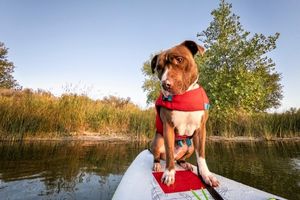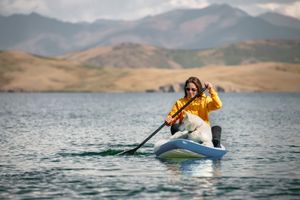Do you love getting out on the water on a paddleboard, canoe, or kayak? If so, you've probably at least considered taking your canine companion with you on your adventures. Enjoying these hobbies with your dog is safe and lots of fun — as long as you follow a few simple rules and guidelines. At veterinarians, we want you and your precious pup to have a blast every time you head out on the water. That's why we decided to share a few pointers for paddling with your pup. Let's dive in!
Refine Your Skills Before Bringing Your Dog Along
If you are new to paddling, you'll need to refine your skills before you can safely bring your pup along for the adventure. You don't have to be an expert, but you do need to be a competent, confident paddler. Even if you're on quiet waters, the situation can quickly become dangerous if you and your dog are inexperienced. Be sure to get in plenty of practice before taking your dog out on the water.

Outfit Your Pup in the Right Gear
Not all dogs are excellent swimmers. That doesn't mean you can't take them paddling, though! Regardless of how strong of a swimmer they are, your dog needs to wear a canine life jacket while on the water. In addition to keeping poor swimmers afloat, dog life jackets help keep your canine companion warm in cool water and make them more visible to other paddlers and boaters. Plus, they have a handle on the back, so you can quickly lift your dog out of the water or board if needed. Consider investing in a pair of doggles (goggles for dogs) too. They'll protect your pup's eyes from water and UV rays (as long as they are willing to wear them).
Bring the following when paddling with your dog:
- The aforementioned canine life jacket and doggles
- Water
- A collapsible water bowl
- Sunscreen
- Treats, of course!
As some dogs are susceptible to sunburns, apply dog-friendly sunscreen regularly to non-haired skin.
Introduce Your Dog to Paddling Slowly
Most dogs who enjoy car rides are good candidates for paddling. That doesn't mean they necessarily feel immediately comfortable or know what to do on the water. Even if you're an expert paddler and can handle even the roughest waters, your canine companion will need some time to get used to the experience. Start in a calm, quiet body of water with an easily accessible launch ramp. If possible, go during the week or at a time when there are fewer boaters and other dogs in the vicinity. Smooth water and limited distractions give you the best chance of success during your initial trips.

Learn Basic Canine First Aid
Knowing what to do in an emergency is always good, especially when trying a new adventure with your dog. Drowning is the most obvious risk when spending time on the water, so make sure you know how to perform mouth-to-snout artificial respiration and CPR.
Hypothermia, dehydration, heat exhaustion, and heat shock are emergencies you need to prepare yourself for. This is particularly important for puppies, elderly dogs, dogs with health problems, small dogs, and brachycephalic (flat-faced) breeds.
Carry an emergency kit with you in case of cuts, snake bites, and other injuries or accidents. Use a dry bag to ensure everything will be ready for use if you need it.
Include these items in your emergency kit:
- Dry towels
- Self-adhesive bandages
- Gauze and tape
- Disinfecting wipes
- Sterile saline to flush wounds or eyes
- Dog-safe antihistamine (talk to your veterinarian)
- Extra doses of any medications your dog needs
- Extra food and water, in case you end up stranded
- A floating leash

Be Mindful of Potential Water Hazards
You and your canine companion may encounter a variety of hazards when spending time in and near a lake, river, stream, or another body of water. Watch out for sharp rocks, glass, shells, and fishhooks, and keep your dog on a leash while on the shore. Contaminants like blue-green algae and pollution are hazards, too. If your dog likes drinking from bodies of water, salt water toxicity and water intoxication are possible. Ensure your dog does not ingest too much water, as doing so could be life-threatening. These problems are often misdiagnosed and can be deadly. Protect your dog by ensuring they aren't lapping up lots of water on your day out.
When you're on the water, keep an eye out for branches, large rocks, and other debris lurking below the surface. Familiarize yourself with local wildlife when paddling in new areas. Some predators could be a threat to your dog (or you). Knowing the potential dangers is one of the best ways to ensure a safe, enjoyable day for you and your pet.
Closing thoughts
Paddling with your canine companion is a great way to get out and enjoy nature. However, if you aren't careful, the consequences can be dire. Protect your pet by following the suggestions above. We also recommend scheduling an appointment before your trip to ensure your dog is up-to-date on necessary vaccinations and in good overall health. Give us a call today to schedule your four-legged best friend's appointment, and we'll make sure they're ready to enjoy their adventure!

